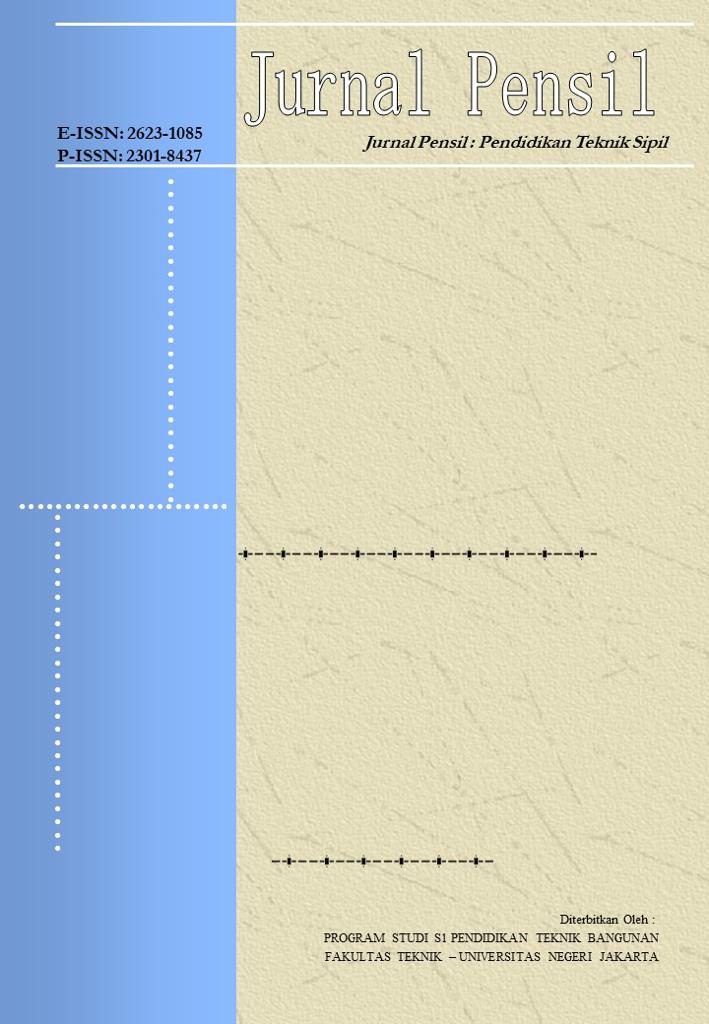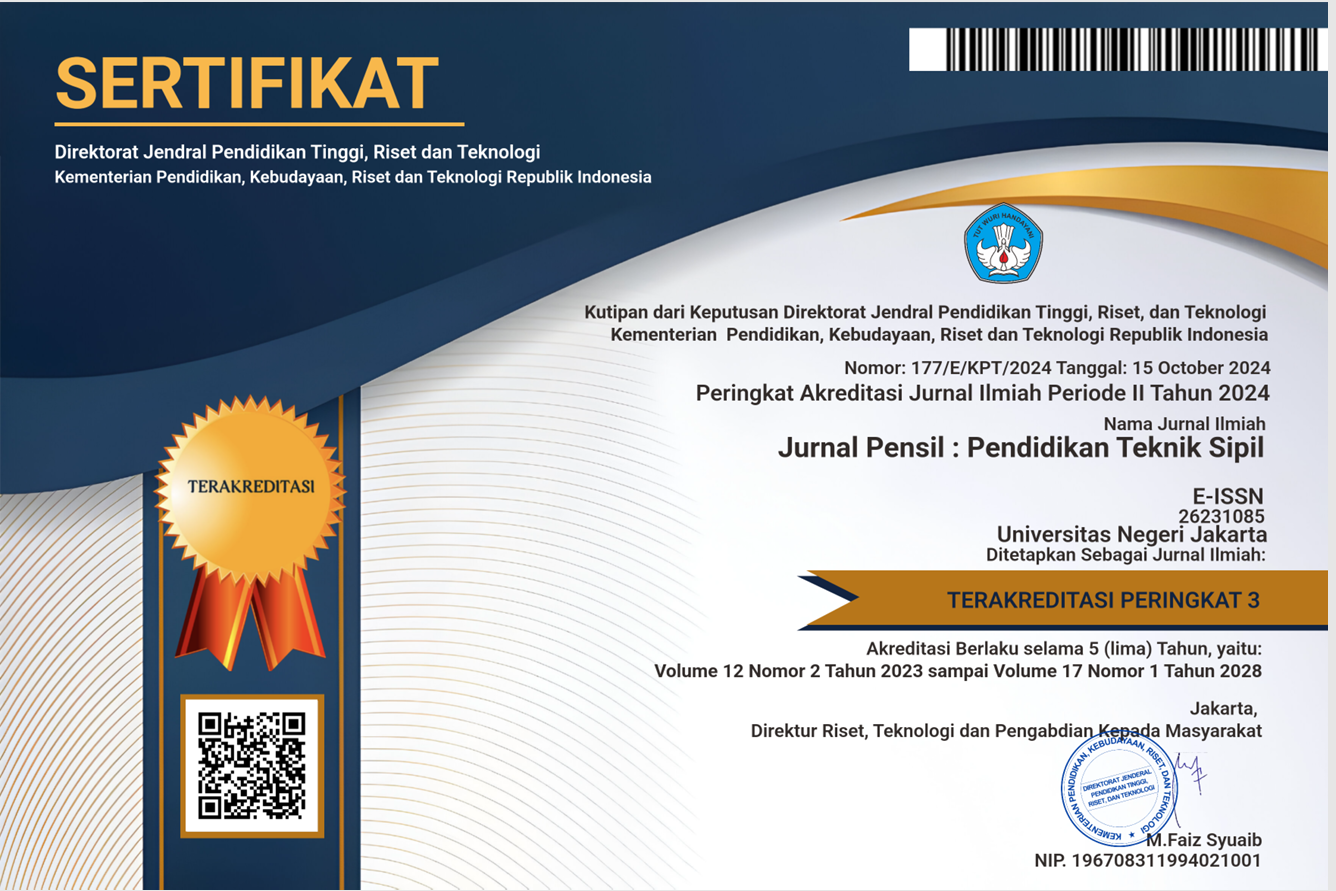STABILITY ASSESSMENT OF ROOT-REINFORCED SLOPES USING FINITE ELEMENT LIMIT ANALYSIS
DOI:
https://doi.org/10.21009/jpensil.v13i2.44244Keywords:
Disaster Mitigitation, Slope Stability, Root Development, Finite Element Limit AnalysisAbstract
Slope instability poses serious threats to infrastructure and environmental sustainability. As a result, numerous reinforcement techniques have been used as disaster mitigation attempts to prevent slope failure. Among various traditional slope reinforcement methods, the use of vegetion root is more cost-effective and environmentally friendly. This paper presents stability assessment of root-reinforced slopes. Firstly, slope models were built for case of bare and root-reinforced slopes. The slope angles were varied in the range of 15º ~ 55 º. The root cohesion and depth of root zone were adjusted within the ranges of 0 ~ 20 kPa and 0 ~1.5 m, respectively. The strength reduction finite element limit analysis method was applied to evaluate the stability of the slopes in this study. The results indicate that factor of safety increases with the increasing of root cohesion and depth of root zone. The best factor of safety was obtained for the case with root cohesion and depth of root zone of 20 kPa and 1.5 m, respectively. Shear dissipation contours of the slope models also show that root reinforcement reduces shear dissipation energy along the failure surface, consequently lowering the possibility of slope failure.
References
Ayazi, M. F., & Tangri, A. (2021). Stabilization of soil nailed slope by flexible materials. Materials Today: Proceedings, 49, 1950–1955. https://doi.org/10.1016/j.matpr.2021.08.134
Badhon, F. F., Islam, M. S., & Islam, M. A. (2021). Contribution of Vetiver Root on the Improvement of Slope Stability. Indian Geotechnical Journal, 51(4), 829–840. https://doi.org/10.1007/s40098-021-00557-0
Bari, F., Repadi, J. A., Andriani, Ismail, F. A., & Hakam, A. (2022). OPTIMAL COST OF SLOPE STABILIZATION WITH RETAINING WALL. International Journal of GEOMATE, 22(93), 83–90. https://doi.org/10.21660/2022.93.3129
Broda, J., Grzybowska-Pietras, J., Gawłowski, A., Rom, M., Przybylo, S., & Laszczak, R. (2017). Application of Wool Geotextiles for the Protection of Steep Slopes. Procedia Engineering, 200, 112–119. https://doi.org/10.1016/j.proeng.2017.07.017
Burak, E., Dodd, I. C., & Quinton, J. N. (2021). Do root hairs of barley and maize roots reinforce soil under shear stress? Geoderma, 383. https://doi.org/10.1016/j.geoderma.2020.114740
Cho, M. T. T., Chueasamat, A., Hori, T., Saito, H., & Kohgo, Y. (2021). Effectiveness of filter gabions against slope failure due to heavy rainfall. Soils and Foundations, 61(2), 480–495. https://doi.org/10.1016/j.sandf.2021.01.010
Chok, Y. H., Jaksa, M. B., Kaggwa, W. S., & Griffiths, D. V. (2015). Assessing the influence of root reinforcement on slope stability by finite elements. International Journal of Geo-Engineering, 6(1). https://doi.org/10.1186/s40703-015-0012-5
Cronkite-Ratcliff, C., Schmidt, K. M., & Wirion, C. (2022). Comparing Root Cohesion Estimates from Three Models at a Shallow Landslide in the Oregon Coast Range. GeoHazards, 3(3), 428–451. https://doi.org/10.3390/geohazards3030022
Duan, X., Zhang, J., Liu, L., Hu, J., & Xue, Y. (2024). Hybrid response surface method for system reliability analysis of pile-reinforced slopes. Journal of Rock Mechanics and Geotechnical Engineering. https://doi.org/10.1016/j.jrmge.2023.12.013
Farichah, H., & Hutama, D. A. (2020). Probabilistic stability and sensitivity analysis of rock slope subjected to seismic loading. Journal of Physics: Conference Series, 1517(1). https://doi.org/10.1088/1742-6596/1517/1/012029
Fata, Y. A., Hendrayanto, Erizal, Tarigan, S. D., & Wibowo, C. (2022). Vetiver root cohesion at different growth sites in Bogor, Indonesia. Biodiversitas, 23(3), 1683–1692. https://doi.org/10.13057/biodiv/d230360
Gallage, C., Abeykoon, T., & Uchimura, T. (2021). Instrumented model slopes to investigate the effects of slope inclination on rainfall-induced landslides. Soils and Foundations, 61(1), 160–174. https://doi.org/10.1016/j.sandf.2020.11.006
Ganepola, G. A. C., Nawagamuwa, U. P., Kumara Karunarathana, A., Ganepola, G. A. C., Kankanamge, L., Nawagamuwa, U. P., Karunarathna, A. K., & Arambepola, N. M. S. I. (2021). Effects of root tensile strength of vegetation on slope stability. https://www.researchgate.net/publication/356925131
Ghadrdan, M., & Mokhtari, H. (2021, February 2). Simple Innovative Method for Online Condition Monitoring of IGBTs in Back-to-Back Converters. 2021 12th Power Electronics, Drive Systems, and Technologies Conference, PEDSTC 2021. https://doi.org/10.1109/PEDSTC52094.2021.9405859
Goyal, A., & Shrivastava, A. K. (2022). Analysis of conventional and helical soil nails using finite element method and limit equilibrium method. Heliyon, 8(11). https://doi.org/10.1016/j.heliyon.2022.e11617
Guo, H., Qu, C., Liu, L., Zhang, Q., & Liu, Y. (2024). Reliability analysis of vegetated slope considering spatial variability of soil and root properties. Computers and Geotechnics, 169. https://doi.org/10.1016/j.compgeo.2024.106257
Hu, C., Zeng, Y., & Yao, H. (2024). Stability analysis of slopes with cracks using the finite element limit analysis method. Frontiers in Earth Science, 12. https://doi.org/10.3389/feart.2024.1364347
Hutama, D. A., & Farichah, H. (2020). Evaluation of Probabilistic Slope Stability Due to Updating of Indonesia Seismic Hazard Maps. IOP Conference Series: Earth and Environmental Science, 469(1). https://doi.org/10.1088/1755-1315/469/1/012084
Ji, X., Xu, L., & Yang, G. (2020). Influence of root morphology on ecological slope protection. E3S Web of Conferences, 198. https://doi.org/10.1051/e3sconf/202019804036
Lann, T., Bao, H., Lan, H., Zheng, H., & Yan, C. (2024). Hydro-mechanical effects of vegetation on slope stability: A review. Science of The Total Environment, 171691. https://doi.org/10.1016/j.scitotenv.2024.171691
Luo, F., Zhang, G., Liu, Y., & Ma, C. (2018). Centrifuge modeling of the geotextile reinforced slope subject to drawdown. Geotextiles and Geomembranes, 46(1), 11–21. https://doi.org/10.1016/j.geotexmem.2017.09.001
Oberhollenzer, S., Tschuchnigg, F., & Schweiger, H. F. (2018). Finite element analyses of slope stability problems using non-associated plasticity. Journal of Rock Mechanics and Geotechnical Engineering, 10(6), 1091–1101. https://doi.org/10.1016/j.jrmge.2018.09.002
Peng, P., Li, Z., Zhang, X., Zhang, W., & Dong, W. (2023). Efficient Method for Calculating Slope Failure Risk Based on Element Failure Probability. Applied Sciences (Switzerland), 13(8). https://doi.org/10.3390/app13084806
Poulsen, P. N., & Olesen, J. F. (2024). Uniqueness of Finite Element Limit Analysis solutions based on weak form lower and upper bound methods. International Journal of Solids and Structures, 286–287. https://doi.org/10.1016/j.ijsolstr.2023.112532
Raghuvanshi, T. K. (2019). Plane failure in rock slopes – A review on stability analysis techniques. In Journal of King Saud University - Science (Vol. 31, Issue 1, pp. 101–109). Elsevier B.V. https://doi.org/10.1016/j.jksus.2017.06.004
Sarkar, S., & Chakraborty, M. (2021). Stability analysis for two-layered slopes by using the strength reduction method. International Journal of Geo-Engineering, 12(1). https://doi.org/10.1186/s40703-021-00153-4
Schlotfeldt, P., Elmo, D., & Panton, B. (2018). Overhanging rock slope by design: An integrated approach using rock mass strength characterisation, large-scale numerical modelling and limit equilibrium methods. Journal of Rock Mechanics and Geotechnical Engineering, 10(1), 72–90. https://doi.org/10.1016/j.jrmge.2017.09.008
Shiau, J., Lai, V. Q., & Keawsawasvong, S. (2023). Multivariate adaptive regression splines analysis for 3D slope stability in anisotropic and heterogenous clay. Journal of Rock Mechanics and Geotechnical Engineering, 15(4), 1052–1064. https://doi.org/10.1016/j.jrmge.2022.05.016
Siacara, A. T., Napa-García, G. F., Beck, A. T., & Futai, M. M. (2020). Reliability analysis of earth dams using direct coupling. Journal of Rock Mechanics and Geotechnical Engineering, 12(2), 366–380. https://doi.org/10.1016/j.jrmge.2019.07.012
Song, X., & Tan, Y. (2024). Experimental study on the stability of vegetated earthen slopes under intense rainfall. Soil and Tillage Research, 238. https://doi.org/10.1016/j.still.2024.106028
Su, X., Zhou, Z., Liu, J., Cao, L., Liu, J., & Wang, P. (2021). Estimating slope stability by the root reinforcement mechanism of Artemisia sacrorum on the Loess Plateau of China. Ecological Modelling, 444. https://doi.org/10.1016/j.ecolmodel.2021.109473
Taha, N. A., Shariff, M. S. M., & Ladin, M. A. (2022). Case Study on Analyses of Slope Riverbank Failure. Modelling and Simulation in Engineering, 2022. https://doi.org/10.1155/2022/1965224
Tschuchnigg, F., Schweiger, H. F., Sloan, S. W., Lyamin, A. V., & Raissakis, I. (2015). Comparison of finite-element limit analysis and strength reduction techniques. Geotechnique, 65(4), 249–257. https://doi.org/10.1680/geot.14.P.022
Wang, L. P., Wang, T., Hu, Y., Liao, W., & Ji, J. (2023). Reliability analysis of pile stabilized earth slopes using weighted uniform simulation method. Computers and Geotechnics, 162. https://doi.org/10.1016/j.compgeo.2023.105623
Xue, K., Ajmera, B., Tiwari, B., & Hu, Y. (2016). Effect of long duration rainstorm on stability of Red-clay slopes. Geoenvironmental Disasters, 3(1). https://doi.org/10.1186/s40677-016-0046-9
Yamase, K., Ikeno, H., Hotta, N., Imawaka, M., Ohashi, M., Tanikawa, T., Todo, C., Dannoura, M., & Hirano, Y. (2024). Effect of sprouting and corresponding root distribution of the shrub species Eurya japonica on slope stability. Catena, 238. https://doi.org/10.1016/j.catena.2024.107869
Yang, H. Q., & Zhang, L. (2024). Bayesian back analysis of unsaturated hydraulic parameters for rainfall-induced slope failure: A review. In Earth-Science Reviews (Vol. 251). Elsevier B.V. https://doi.org/10.1016/j.earscirev.2024.104714
Yingchaloenkitkhajorn, K. (2019). Analysis of embankment slope stability: the comparison of finite element limit analysis with limit equilibrium methods. MATEC Web of Conferences, 270, 02004. https://doi.org/10.1051/matecconf/201927002004
Yoshida, S., Xiong, X., & Matsumoto, T. (2023). Experimental and numerical study on reinforcement effect of plate anchors or flip anchors on model slopes. Soils and Foundations, 63(2). https://doi.org/10.1016/j.sandf.2023.101285
Zhang, T., Guo, X., Baroth, J., Dias, D., & Martinez-Frias, J. (2021). Metamodel-Based Slope Reliability Analysis-Case of Spatially Variable Soils Considering a Rotated Anisotropy. https://doi.org/10.3390/geosciences
Zhou, C., Hu, Y., Xiao, T., Ou, Q., & Wang, L. (2023). Analytical model for reinforcement effect and load transfer of pre-stressed anchor cable with bore deviation. Construction and Building Materials, 379. https://doi.org/10.1016/j.conbuildmat.2023.131219











.png)
.png)
1.png)

